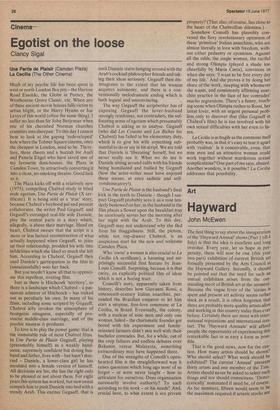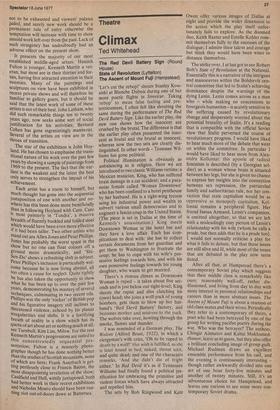Art
Hayward
John McEwen
The first thing to say about the inauguration of the 'Hayward Annual' shows (Part 1 till 4 July) is that the idea is excellent and long overdue. Every year, let us hope in perpetuity, there will now be one (this year two-part) exhibition of current British art formally presented by the Arts Council at. the Hayward Gallery. Secondly, it should be pointed out that the need for such an annual exhibition arises from the outstanding merit of British art at the moment. Because the vogue fever of the 'sixties is spent and present art activity seems rather slack as a result, it is often forgotten that there are probably more quality artists alive and working in this country today than ever before. Certainly there are more with international reputations and international contact. The 'Hayward Annuals' will afford people the opportunity of experiencing this remarkable fact in as easy a form as possible.
That is the good news, now for the caution. How many artists should be shown? Who should select? What work should be exhibited? The current 'Annual' presents thirty artists and one member of the Tate. Artists should never be asked to select such things and nor should committees. 'Democratically' nominated if need be, of course. As for numbers, fifteen would seem to be the maximum required if artistic stocks are
not to be exhausted and viewers' palates jaded, and surely new work should be a permanent rule of entry otherwise the temptation will increase with time to show unsold work left over from the past. Lack of such stringency has undoubtedly had an adverse effect on the present show.
It presents the majority of our most established middle-aged artists. Hamish Fulton is younger, Kenneth Martin a veteran, but most are in their thirties and forties, having first attracted attention in their twenties. Many of the paintings and sculptures on view have been exhibited in recent private shows and will therefore be familiar to gallery goers, but it should be said that the latest work of some of these artists is not of their best. John Latham, who did such remarkable things ten to twenty years ago, now seeks some sort of social justification for his activities; Bernard Cohen has gone ingratiatingly mannerist. Several of the artists on view are in the throes of transition.
The star of the exhibition is John Hoyland. He has chosen to emphasise the transitional nature of his work over the past few years by showing a sample of paintings from 1969 to the present. The fact that the earliest is the. weakest and the latest the best only serves to strengthen the impact of his achievement.
Each artist has a room to himself, but much thought has gone into the sequential justaposition of one with another and nowhere has this been done more beneficially than in following Hoyland with Caro. Caro is most painterly in 'Tundra', a massive breadth of fluently. buckled and folded steel Which would have been even more effective if it had been taller. Two othenartists who stand out are Allen Jones and Peter Phillips. Jones has probably the worst space in the show but no one can float colours off a ground more dramatically, and `ShiSeri-Do' shows a refreshing shift in subject. Peter Phillips's inclusion is particularly welcome because he is now living abroad, all too often a cause for neglect. Quite rightly he has also taken the opportunity to show What he has been up to over the past few Years, demonstrating his mastery of several techniques, culminating in two recent oils. Phillips was the only 'rocker' of British pop and his figurative imagery still inclines to threatened violence, echoed by his planar irregularities and shifts. It is a fortifying breath of reality in a show which has its quota of an about art or nothing much at all, see Turnbull, Kim Lim, Milow. For the rest Kenneth Martin's progressions are suited to this concentratedly sequential presentation; Fulton is a masterly photographer though he has done nothing better than the studies of Scottish mountains, none of which are here; Frank Auerbach is getting perilously close to Francis Bacon, the most disappointing revelation of the show; Caulfield and Hall, wittily juxtaposed, both had better work in their recent exhibitions and Nicholas Monro should have been running riot out-of-doors down at Battersea.



































 Previous page
Previous page